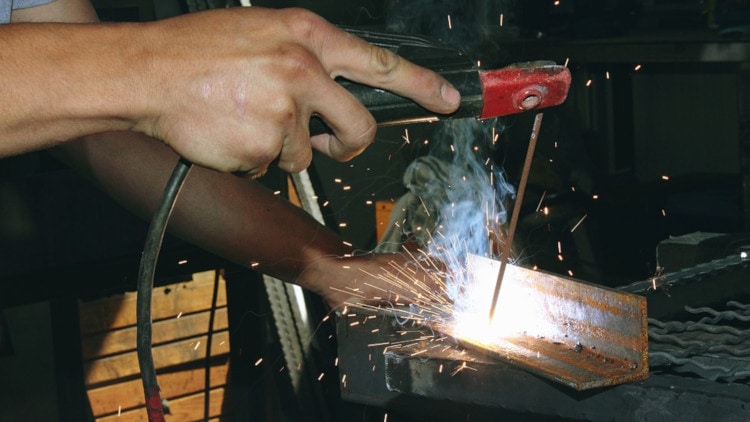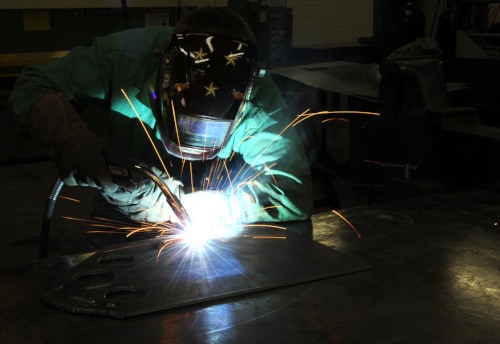what type of welding can be done to chevy iron heads
0
How to Weld Cast Iron: A Full Guide (with Pictures)
Final Updated on

Image credit: CC0 Public Domain, Max Pixel
It'south a nightmare for any cast-atomic number 26 machine owner to crack or interruption a vital cast component. Information technology tin hateful thousands of dollars in replacement parts or hundreds of dollars for hiring a cast-iron welding specialist. Either option can exist called, just if you lot know how to weld and are upwardly for learning a new skill, welding it yourself could solve your problem just as hands.
Bandage iron is one of the most challenging materials to weld. A incorrect movement tin ruin your cleaved role fifty-fifty more, or worse, make your weld look strong when it'south internally weak. Therefore, knowing what you're doing is more crucial than ever. Following a gear up of guidelines on how to weld cast iron should ensure that your welds have no cracks and that the internal strength is sufficient to withstand the component's purpose.
Determining the Blazon of Cast Iron
The outset step of this kind of welding is identifying what type of cast fe information technology is. At that place are numerous types, and you won't want to weld most of them. Here is a listing of their weldability:
Gray iron: Weldable with difficulty.
White fe: Almost unweldable.
Ductile atomic number 26: Weldable but rare, every bit it's an extensive and irksome procedure.
Malleable iron: Not welded, equally welding changes the properties of the metal, rendering it useless.
The best way to tell what type of bandage iron needs welding is to consult the product transmission or contact the manufacturer, if it'due south not stated on the material. There's a slight difference in the expect of fresh cracks in the cloth, but unless you're experienced in determining this, information technology pays to find out from the manufacturer.
Gray bandage iron is the virtually common blazon of cast iron welded, and should be the only cast iron you attempt to fuse unless you lot're experienced with casting or welding it. Having someone experienced assist you is some other practiced option.
Choose the Welding Process
In one case yous've determined the textile is grey bandage iron, the next pace is choosing what process you will use to weld it. You can weld cast iron with every welding procedure, provided you use the right filler material and welding procedure. It'southward primarily based upon personal preference, but in that location are a few factors to consider when welding cast fe.
If you're welding up a machined surface, the best option would be to TIG weld information technology. The spatter from MIG or stick welding may unnecessarily damage parts of the machined surface not being welded. TIG welding shouldn't give you any spatter issues.
Oxy-acetylene welding is another pick frequently used to weld cast fe. Information technology's a expert option to minimize the farthermost heating and cooling of the electrical welding processes, and information technology'south easier to maintain the temperatures of the components with it.
Brazing isn't really welding, as it doesn't fuse the metal as a weld does. Yet, it'south a skillful option if you're having trouble welding it for some reason. Make certain the surfaces the brazing will stick to are cleaned well, every bit it won't stick to muddy or rusty iron.
Stick and MIG welding are both desirable options with the right consumables. With the wrong filler metal, it will most likely cause bully, and so be sure you know it's the right selection to weld cast fe.

Image credit: Airman 1st Course David Bernal Del Agua, Mconnell Air Strength Base
Choose the Filler Wire or Electrode
There is only a small-scale range of filler wire and electrodes that volition weld cast iron properly. Most of the ones available that haven't been designed specifically for cast iron cool too quickly and cause stress cracks, or don't fuse properly with the cast iron.
Electrode and wire consumables
Rich nickel content: This is the all-time blazon of electrode or wire, as it's soft and machinable. It doesn't absurd also quickly and looks the same equally cast iron. All the same, these are the most expensive consumables and aren't suited for welding thick sections.
55% nickel, 45% fe mix: This is a more affordable price and looks the same as cast fe when welded. It produces a machinable weld, although it's much harder than the 99% nickel welds. It has much lower weld shrinkage than most iron rods, meaning it minimizes keen.
Iron: This blazon costs less and produces a different-colored weld than the cast iron. It is much more challenging to employ as information technology has higher shrinkage backdrop. It's also non machinable, as it hardens during the welding process, but it tin can be ground back.
Stainless steel: Bandage iron fused with austenite stainless steel doesn't harden and modify properties and so much with iron consumables. The stainless steel does aggrandize and contract significantly during the heating and cooling of the welding process, then it's challenging to employ. All the same, it'due south used to weld cast iron and produces a machinable surface.
Brazing bronze: You can oxy-acetylene braze or use the rods with a TIG welder. It's a skillful way to provide a potent hold in a crack or betwixt two components needing joining, while not causing swell and a modify of the cast iron properties.
- See also: How to Repair Wrought Iron without Welding
Cleaning and Peening Weld Surfaces
Like most welding, the cleaner the surface is, the better your welds will exist. Sometimes the material y'all're welding has had a lifetime'due south worth of fumes or oil throughout the casting, and this will cause challenges in welding. There are sure things to exist aware of when yous weld bandage fe.
Using welding consumables, like the MG-289 Bandage Iron Welding Alloy rods, that are designed for contaminated cast iron is the best style to ensure the weld is sufficient.
Peening is the procedure of tapping the soft weld every bit it cools with a ball-peen hammer to foreclose cracking. This should be done with circumspection and only when the weld tin can deform, simply it'due south not ever necessary, as what primarily causes cracks is the irregular or rapid heating or cooling of the component. Preheating and slowly cooling your project is what'south most important.

Prototype credit: 6782865, Pixabay
Preheat or Cold-Weld?
There are a few different opinions on whether y'all should weld hot or common cold. Everyone agrees that preheating is a skillful option, but there are a few people suggesting welding with minimal estrus is sufficient as well.
When deciding on how to weld cast atomic number 26, taking i of these approaches is necessary, because different well-nigh metals, cast iron is breakable and has very minimal ability to deform through bending or expansion and contraction. Heat always has a deforming effect on metal, and if i part of the metal heats or cools faster than another, stress and great occur in the cast iron or weld.
Preheating minimizes this effect by bringing the surrounding area of the weld nearer to the welding temperature, making the whole component modify uniformly. Cast iron changes characteristics over 1400 degrees Fahrenheit, so it'southward crucial not to put excessive heat into the component.
Welding bandage atomic number 26 in a cool manner without preheating and using minimal heat is thought to help this by reducing the overall temperature. This can be beneficial in not producing visible cracks, and information technology volition exist a stronger weld than a hot weld without preheating. Yet, internal stress withal occurs, which tin can show afterward on in the component's life, and it produces an overall weaker weld than properly preheating earlier welding.
Experienced cast iron welders who piece of work on repairing or manufacturing cast iron products regularly always and merely preheat. This is the all-time way to ensure the weld is potent internally, non but visibly crackless.
Cool Slowly
1 of the most crucial parts of welding bandage iron is the cooling process. You lot should never quench the weld with anything cold like h2o or compressed air. Instead, the slower the whole component cools, the improve.
Some welds are cooled over many days, but greyness cast fe isn't as critical. Putting the welded piece into sand or a warm oven can aid information technology absurd slowly in a more than uniform way than having it residuum on the demote. Sometimes information technology is more challenging to achieve this, and you can withal produce a quality weld without extending the cooling time excessively. However, the slower it cools, the amend a outcome you lot'll have.
Decision: How to Weld Cast Atomic number 26
Welding cast iron is no easy task. It requires significantly more preparation and care during the welding and cooling process. However, it'southward a metal that's commonly welded and can produce a potent component that will last just as well as a cast product without welds.
Be sure to follow all the necessary steps on how to weld bandage iron, and you will produce the results y'all need for your adjacent cast iron project. If you lot take any shortcuts, the weld will almost likely crack, or exist internally weak and may non final long.
Nosotros hope you relish successfully welding some bandage iron with this guide. Feel gratuitous to get out united states your comments below in our annotate section.
Sources
- https://www.welding-directorate.com/Welding-ductile-atomic number 26.html
- https://www.esabna.com/euweb/oxy_handbook/589oxy15_3.htm
- https://world wide web.lincolnelectric.com/en-us/support/welding-how-to/Pages/welding-cast-iron-detail.aspx
- https://weldingwire.com/Images/Interior/documentlibrary/cast%20iron%20welding%20alloys.pdf
- https://www.reliance-foundry.com/blog/how-to-weld-cast-iron#gref
- Determining the Type of Cast Fe
- Choose the Welding Procedure
- Cull the Filler Wire or Electrode
- Electrode and wire consumables
- Cleaning and Peening Weld Surfaces
- Preheat or Cold-Weld?
- Absurd Slowly
- Conclusion: How to Weld Cast Atomic number 26
Cameron Dekker
Cameron grew up in Allentown, Pennsylvania, a in one case-proud steel town on the Lehigh River, where he got a gustation of TIG welding in his high school store course. He holds certificates for Certified WeldingEducator (CWE) and Certified Resistance Welding Technician (CRWT) from the American Welding Found. His interests include scuba diving, sculpture, and kayaking.
lackeylacteciduch.blogspot.com
Source: https://waterwelders.com/how-to-weld-cast-iron/
Post a Comment for "what type of welding can be done to chevy iron heads"